Abstract
Collective Thomson scattering technique based on high power laser has already proved its ability in measuring the ion (bulk and fast) temperature (T i) in fusion plasma devices like tokamaks and stellarators. This paper present first trial to implement collective Thomson scattering diagnostic based on quasi-optical gyrotron as a source of radiation. It was found utilization of this wavelength band gives more flexibility in diagnostic port arrangement.
Similar content being viewed by others
References
J. Sheffield, Plasma scattering of electromagnetic radiation, Academic Press, London, (1975)
T.P. Hughes and S.R.P. Smith, Rev. Sci. Instrum., 72(6), 1988 (1075).
H. Bindslev J. Hoekzeina, TI. Hnges and J. Machuzak Phys. Rev. Lett., 83, 1999 (3206).
E.E. Salpeter Physical Reviev, 72, 1960 (1528)
T. Simosuma S. Kubo, M. Sato et al., Fusion Eng. and Design, 53, 2001
Author information
Authors and Affiliations
Rights and permissions
About this article
Cite this article
Pavlichenko, R., Ogawa, I., Idehara, T. et al. Design of the Collective Thomson Scattering Diagnostics for Large Helical Device Using a Quasi-Optical Frequency Tunable Gyrotron as a Radiation Source. International Journal of Infrared and Millimeter Waves 23, 1683–1690 (2002). https://doi.org/10.1023/A:1021439116909
Issue Date:
DOI: https://doi.org/10.1023/A:1021439116909




